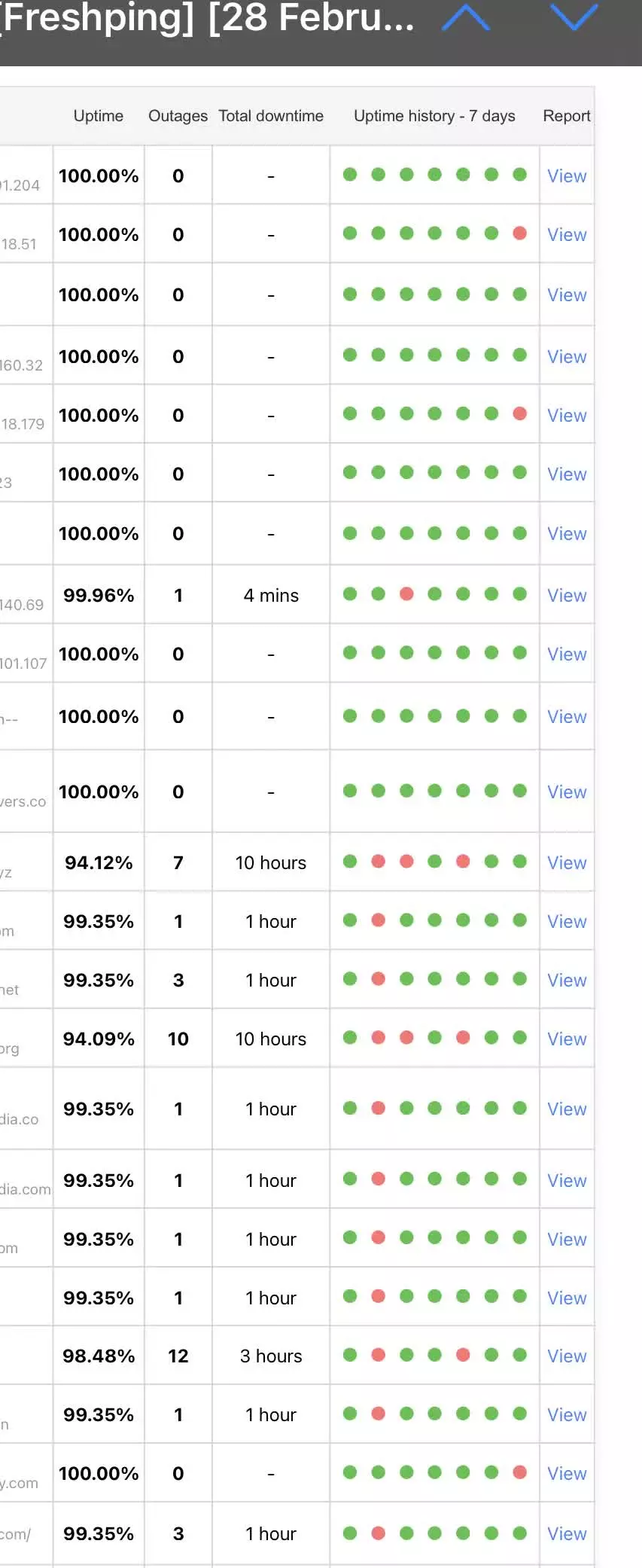This post about tools for monitoring server uptime is a follow up to my post titled “How to monitor uptime of your websites?” In that post, I had discussed the types of such monitors, as well as a list of uptime tracking tools. During research for that post, I installed no less than 6 different server alert services for my sites !
Back story: Why I wrote this post

I experienced the “perfect storm” this week with my website.This morning, I was looking up analytics on this blog, number of visits had dropped to 10 percent of daily traffic. I am aware that google algorithms have changed (again) and many are experiencing a drop in traffic… but the numbers were alarming. What exactly went wrong? Possible causes I thought of and checked: a. Changing registrars (long story short, my former registrar pooped and I moved several domains to Porkbun and CloudFlare or CF). But all domains were on CF so should not have been an issue. b. SSL issue – but certification were valid, SSLlabs showed A or A+ rating. c. Site is managed through Gridpane, which sent no errors. d. None of the three Uptime monitors sent an alert about downtime. I use Hetrix Tools, Uptime Robot and Screpy. e. Ping to server showed no result – probably because I use VPN that has been blocked.
Finally, fired up control panel at the vpn provider- lo and behold, server was offline.
Wonder why the alerts did not trigger- maybe because I was only checking the domain and not ip?
Tools for Monitoring Server Uptime used
In second half of 2020, I used the following uptime tracking services (In alphabetical order)
Bearmon, Freshping, Hetrix Tools, Netumo, Uptime Robot, Zilore
Typically, it is good to have one set of tracking system, and a second for backup. From that perspective, two different uptime services for servers should suffice. But six was an overkill.
Need to rationalize for efficiency
I always intended to reduce the number of server monitoring services towards end of 2020. During this six month time period, what was not anticipated was the sheer number of downtimes (and corresponding alerts from monitoring services). A KVM and OVZ VPS each from Hostslick was down for a long time. So also, VPS from the now-defunct service, HostSolutions in recent times. I would get multiple email alerts from the monitors, which would really flood my email box! I discontinued some older services and signed up for new ones during Black Friday 2020. Manually, I had to update each of the 6 uptime services. Some site downtime alerts kept throwing false positives.
The was a classic case of problem of plenty. There was a stark need to consolidate.
Consolidating the Uptime Monitoring Services
By end of December 2020, the decision was made to use three monitoring sites or services, namely, Hetrix Tools, Uptime Robot, and Freshping. From the original six, Bearmon, Netumo and Zilore will have to go. Of which, Netumo and Zilore have already been cancelled.During Black Friday 2020 sale. I signed up for a paid subscription for HetrixTools for around 30 US dollars a year. Having used this tool the most (and the longest), it was time to opt for paid subscription. Three is still a lot of services for monitoring server uptime, but better than having six!
Also read my post How to Monitor Uptime of your website
Steps Taken to consolidate monitoring services
As I started optimizing the uptime monitoring tools, a couple of oops’es occurred. The email address that I had set up for receiving alerts from Hetrix Tools was one of them. Because a mis-configuration of settings on my part, no email alerts were received when two of my servers went offline. These were brand-new services, and not set up on only two services- Bearmon and Hetrix tools. Fortunately, Bearmon picked it up, since that service is linked to a different email account.
False Positive or server error?
When I logged on to the Virtualizor server management panel for that provider (IonSwitch) the server panel indeed showed the virtual machine to be offline. Logging on to VNC, and running the command showed errors.
It may have been a case of false positive from virtualizor, or a software bug. Long story short, the server was not accessible to the outside world. It is likely that the VPS may very well have been running all this time. It was either an external networking issue or something else was going on. This was a clear signal that merely having multiple server monitoring tools is not adequate. One has to use them efficiently and effectively.
Way forward with Server Monitoring Tools
The part of my journey where I used the 6 server uptime tracking services has come to its logical conclusion.The combination of three different monitoring tools, is still a log, but I will stay with them for the first part of this year. By mid-2021, my goal is to go back to the original set of two tools: Hetrix Tools and (either of) Uptime Robot and Freshping. I have also read up on multiple DIY / Self hosted setups for server uptime monitoring, since publishing the original post. Those I have decided to try for a later time.  Update February 2022: I have revisited the setup for the uptime monitors that I use: Hetrix Tools, Uptime Robot, Screpy, and Freshping. Each service will now have two different monitors, checking the service at different intervals. Hope this will resolve the issue of not receiving alerts!
Update February 2022: I have revisited the setup for the uptime monitors that I use: Hetrix Tools, Uptime Robot, Screpy, and Freshping. Each service will now have two different monitors, checking the service at different intervals. Hope this will resolve the issue of not receiving alerts!
This post was published under the category Web Hosting and was last updated on 30 August 2023 24 February 2024


